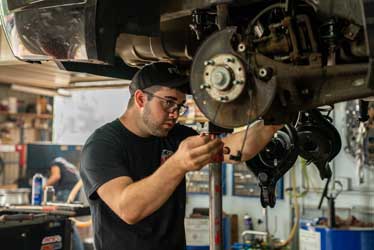All Categories
Featured

Two essential services that are usually forgotten yet have a significant effect on tire long life and performance are tire turning and placement. Allow's dive into what tire turning and alignment are and why they're essential for your vehicle.
What Is Tire Turning? Tire turning is the process of moving your tires from one setting to an additional to ensure they use equally. Considering that your auto's tires operate at different rates depending on their setting (front tires versus rear tires), rotating them regularly assists to disperse the wear evenly, resulting in a longer life expectancy for your tires.
Tires on the front axle have a tendency to use extra promptly than those on the rear axle, particularly in front-wheel-drive automobiles, where the front tires take care of both guiding and power. On the various other hand, rear tires may wear erratically relying on the vehicle's weight circulation and driving problems. By rotating your tires every 6,000 to 8,000 miles (or as recommended by the supplier), you'll guarantee an extra well balanced wear pattern.
What Is Tire Alignment? Tire placement, likewise referred to as wheel alignment, refers to readjusting the angles of your cars and truck's wheels to the maker's requirements. Appropriate positioning ensures that your tires are aiming in the appropriate direction, and it assists take full advantage of tire life and enhance automobile handling. There are 3 main facets of positioning: camber, wheel, and toe.
Camber describes the tilt of the tires from the front of the automobile. If your tires are slanted way too much internal or outside, it can trigger unequal wear. Wheel refers to the angle of the steering axis when watched from the side of the cars and truck. This impacts the stability of the steering, specifically when driving right. Toe refers to the angle at which the tires point internal or exterior when checked out from above. This influences exactly how your vehicle tracks when driving. An appropriate alignment makes sure that all 4 tires are aiming straight in advance and are tilted correctly. Imbalance can result from hitting splits, curbs, or simply from the wear of suspension components over time.
Why Tire Rotation and Placement Matter. Extended Tire Life. Both tire turning and alignment aid protect against unequal tire wear. When your tires put on uniformly, they last longer, which can save you money in the lengthy run by lowering the demand for early substitutes.
Improved Safety And Security. Proper tire turning and positioning boost automobile stability and handling. Misaligned tires or erratically used tires can negatively influence your capability to steer and stop your vehicle, specifically in emergency scenarios. Normal maintenance ensures your tires do ideally, supplying a more secure driving experience.
Better Gas Effectiveness. If your tires are not aligned appropriately, they might drag versus the road surface, causing resistance. This added rubbing can decrease gas efficiency, creating your lorry to eat more gas. Routine tire positioning guarantees that your lorry moves efficiently, improving gas mileage.
Improved Convenience. Imbalance or erratically used tires can bring about a rougher adventure, as your car may draw away or cause resonances. By maintaining your tires revolved and lined up, you'll enjoy a smoother and extra comfortable driving experience.
Signs That Your Tires Need Rotation or Placement. It's vital to stay sharp for any type of indicators that your tires need turning or positioning. Look out for these usual signs:
Unequal Tire Wear: If you discover that one tire is substantially much more used than the others, it may be time for a turning or alignment. Steering Pull: If your auto pulls to one side while driving directly, this might suggest misalignment. Resonances: If you really feel vibrations in the guiding wheel or the auto itself, maybe a sign of misalignment or uneven tire wear. Squealing Tires: Uncommon tire noise might also indicate incorrect positioning or the demand for a tire turning. How Usually Should You Rotate and Straighten Your Tires? Tire rotation ought to generally be done every 6,000 to 8,000 miles or as defined in your car's proprietor's handbook. It's a good concept to rotate your tires throughout every oil modification, as this will certainly help you remain on top of routine maintenance.
As for placement, it doesn't need as frequent solution. Typically, positioning needs to be inspected a minimum of yearly or whenever you discover problems like drawing away or resonance. You might also need placement if you have actually hit a huge gap or curb, which can toss your wheels out of positioning.
Conclusion: Maintain Your Tires in Leading Shape. Tire rotation and positioning are important services that keep your car running efficiently, securely, and efficiently. By taking the time to have your tires rotated and lined up frequently, you're spending in your automobile's performance and durability, while also boosting your safety when driving. Stay aggressive with tire upkeep, and your automobile will thanks with far better gas economic climate, improved handling, and extended tire life.
Latest Posts
Identifying When Your Car Needs Expert Vehicle Service at Montclare Auto Repair
Learn How to Cut Costs on Car Maintenance with Montclare Auto Repair’s Limited-Time Deals
Protect Your Home with Quality Residential Roof Covering
More
Latest Posts
Identifying When Your Car Needs Expert Vehicle Service at Montclare Auto Repair
Learn How to Cut Costs on Car Maintenance with Montclare Auto Repair’s Limited-Time Deals
Protect Your Home with Quality Residential Roof Covering